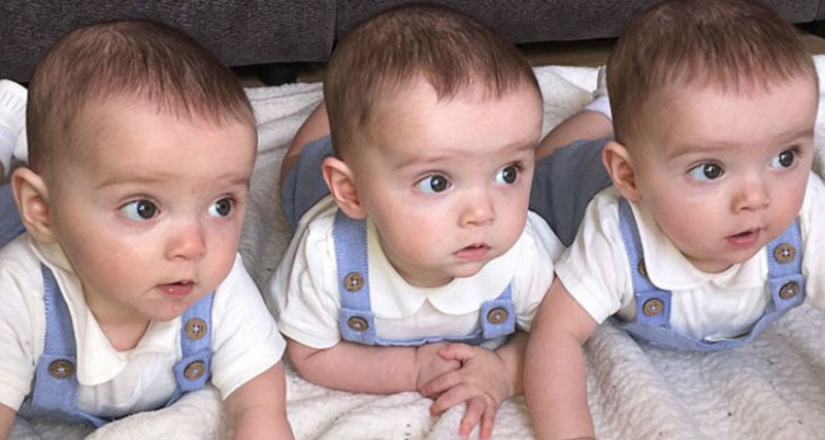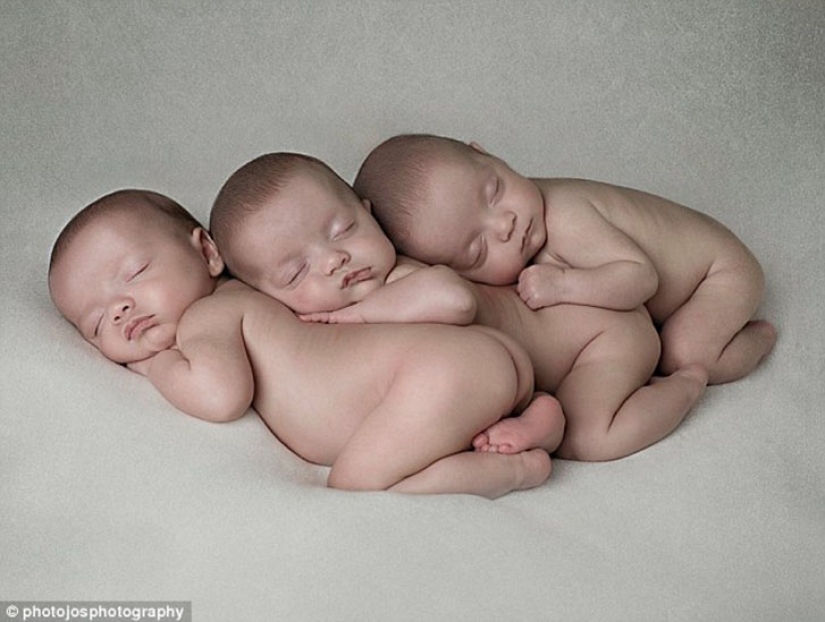Genetic photocopy: British triplets who are distinguished only by their own mother
To find out that she was expecting triplets was already a surprise for Becky-Jo Allen. And when little Roman, Rocco and Roan were discharged from the intensive care unit home, their mother was waiting for another surprise.
Other moms were constantly saying how much the babies looked like each other, and Becky-Jo decided to send DNA samples for analysis. So she found out that we are talking about one case in 200 million: triplets turned out to be absolutely identical from the point of view of genetics.

Source: Daily Mail

Fortunately for the 23-year-old mother, the characteristic features and the manifested character of the kids allow at least her not to confuse the children with each other. "When they were newborns, it was quite difficult to distinguish one from the other, but I myself never confused them," says the young mother.

"They all have birthmarks between their eyebrows, but Roman has it a little darker than the others, and Roan has a birthmark on his leg," she explains. — When they were in the hospital, the doctors said that they were not identical, but since they were discharged, many people have told me that it is impossible to distinguish between babies."
According to the Multiple Birth Foundation, the only way to determine for sure whether twins or triplets are identical, known as establishing zygosity, is DNA analysis.
After consulting with the foundation, Becky-Jo Allen took swabs from the oral cavity of the triplets and sent them to the laboratory for analysis. In early May, she received results according to which her children turned out to be genetically identical. These are the youngest of the few genetically identical triplets known in the UK, conceived naturally.
"I was surprised because I expected them not to be identical," the mother says. "But then it turned out that I'm the only one who distinguishes them from each other, and that explains a lot!" Miss Allen from Gatacre, Liverpool, who also has a three—year-old daughter, Indiana, had an early scan in the ninth week of pregnancy due to severe headaches and nausea. That's when she found out she was expecting triplets.
"I couldn't believe it. I didn't even think that it could be twins, let alone triplets, especially since we didn't have such a thing in our family." Doctors from Liverpool Women's Hospital did scans every week. Triplets were born by Caesarean section at 31 weeks. Rocco weighed 1.5 kg, Roman - 1.53 kg, and Roan — 1.64 kg.
Now that the kids are at home, they begin to show character. "Roan is the loudest, he screams all the time. Rocco is usually quite calm, but he can also be irritable, and Roman usually doesn't want to share with anyone," says their mother.
"They are always crawling after the same toy, trying to get it before the other brothers. Indiana loves them, she's not at all jealous, but I feel a little sorry for her when I think about what it will be like for her to grow up with three brothers."
Triplets need about 130 diapers and four packs of baby wipes per week. A pack of milk mixture lasts for about two days, and the washing machine starts three times a day. The father of the triplets, 28-year-old Liam Tierney, does not live with Becky-Jo, and her 17-year-old sister Lauren helps her the most.
Before Indiana was born, Becky-Jo wanted to become a nurse-midwife, and now she dreams about it even more, especially after everything she's been through. "All the help and medical care that we received was excellent," she notes. "I'm happy that they're all fine now."
Identical triplets are obtained when a fertilized egg divides twice. Without a course of infertility treatment, the probability of such cases ranges from once per 60 thousand to one case per 200 million. If twins or triplets have one membrane in the womb, they are usually identical (monozygotic). If not, their placentas are indistinguishable from those of different (two-digit) twins, and only DNA analysis can determine this for sure.
Keywords: Twins | Uk | Genetics | Identity | Copy | Liverpool | Babies | Triplets | Uniqueness
